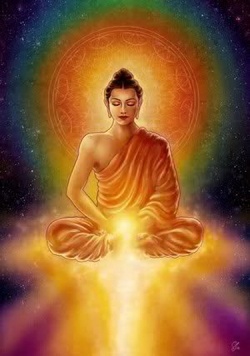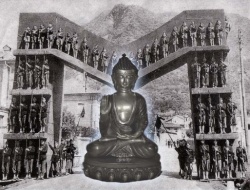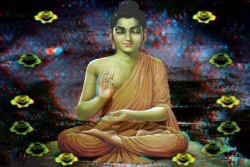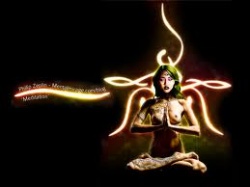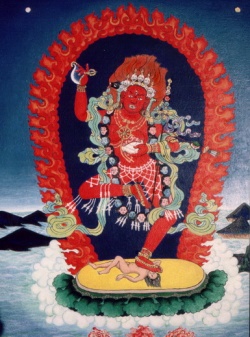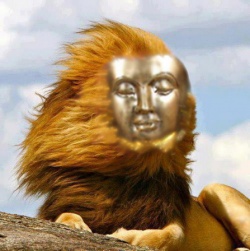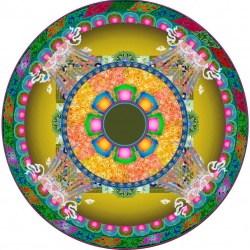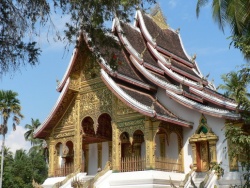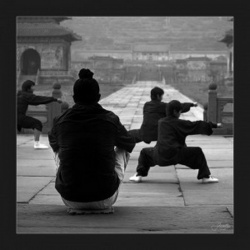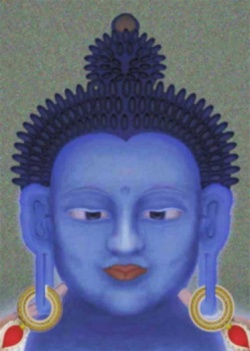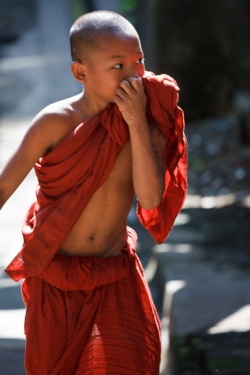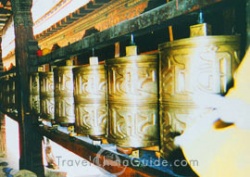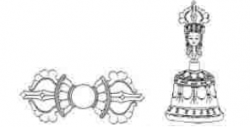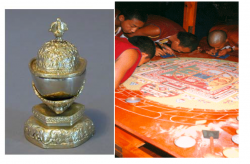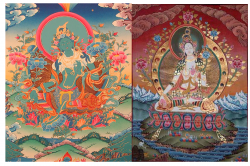Tibetan Buddhism, Symbolism, and Communication Implications in the (Post)modern World
Tibetan Buddhism, Symbolism, and Communication Implications in the (Post)modern World
Rueyling Chuang, California State University, San Bernardino
Abstract
This paper explicates ontological and philosophical underpinnings of Tibetan Buddhism and its relevancy to human communication and interactions. Taking from the author's personal journey and practice of Tibetan Buddhism, and her research interests in intercultural communication, this paper provides examples that integrate essential Tibetan Buddhism teachings, cosmology and communication concepts, specifically with regard to symbolism, cultural values, spirituality, and (post)modernity. Essential Tibetan Buddhist teachings such as mind, body and speech, path to enlightenment, rituals, non-dualistic reality and impermanence are depicted to illustrate its relevancy to communication and everyday life in this (post)modern world.
Introduction
Tibetan Buddhist teachings have increasingly been integrated with western psychology (e.g., Moacanin, 2003) and postmodernism (Olson, 2000). Among all the sects of Buddhism, Tibetan Buddhism and its spiritual leader, the Holy Dalai Lama, have received most attention and fascination from people in the contemporary world, both from the East and the West. Buddhist teachings of non-duality, non-attachment and selflessness transcend fixation with dichotomy and self-absorption. Specifically, Tibetan Buddhist ideas of nature of the mind, loving kindness, an ultimately clear and calm mind, wisdom, and compassion offer insight into human emotions and self-transformation in this sometimes chaotic, fragmented and stressful (post)modern world. Tibetan Buddhism, with its tantric (Vajrayana) tradition, offers skillful means to help individuals reach enlightenment in this lifetime.
These methods are communicated through religious rituals (e.g., initiation ceremony), religious objects (e.g., thunderbolt), meditation, mantras, sacred paintings (Thangka), and mandalas. Thangkas are the sacred paintings of Tibet that contain symbols, signs and images that serve to aid concentration, to inspire, and are believed to liberate an individual. Mandalas represent the entire sacred universe, and are an expression of Buddhist cosmology. These Tibetan Buddhism rituals, sacred objects, thangkas and mandalas are rich with symbolism.
This paper seeks to illustrate fundamental Tibetan Buddhism teachings and spirituality via examination of its connection to modernization, globalization and cross-cultural communication. Tibetan Buddhism highlights the importance of self-transformation and enlightenment through compassion and wisdom and steadfast training of one's own body, speech and mind.
(Post)Modernity and Tibetan Buddhism
The relevancy of Tibetan Buddhism and our everyday life in this increasingly frenzied (post)modern society is the quest for finding inner peace and happiness and the harmonious connection with one’s external world. Tibetan Buddhism, especially meditation, deals with maintaining the perfect balance of relaxation (yin energy) and concentration (yang energy). Through meditation, one ascertains the notion of the middle way (Madhyamika) and one is not overly excitable or depressed. Through chanting mantras, which are sacred sound capturing the cosmic energy, one becomes more in tune with one’s own Buddhist nature and harmonious connection with the universe. It is interesting to note that the notion of maintaining the middle way (Madhyamika) is particularly important in dealing with conflicts in our everyday life. For example, Wilmont & Hocker (2001) advised that midrange and the middle way is the “zone of effectiveness” in regulating conflict. They further stated, “in our struggles with others, moderated conflicts have the greatest potential for productive management, whereas suppressed, ineffectively avoided conflict and unrestrained, runaway conflict spirals are equally unproductive” (p. 242). Dealing with conflict, in this regard, is meditative. To reach a perfect balance one cannot be overly excited or nervous or the body becomes too tense to reach a peaceful mind, whereas, if a person becomes too relaxed to the point that one accidentally falls asleep, the person is not being mindful and thus cannot obtain insights.
In addition to using the middle way to deal with our everyday life, which sometimes can be stressful and laden with conflicts, Buddhist ontological assumption of undualistic reality is particularly relevant to the postmodern perspective. The culture of postmodern society contains several dialectical features such as the blurry boundary between what is real versus what is illusionary, a la Baudrillard’s notion of hyperreality. In the age of so-called simulacra, where images appear to be real but not real, the reality becomes fuzzy and fragmented. The images in which we live “are neither real nor false in the old sense of things—they are hyperreal” (Billing, 1994). One of the essential ontological assumptions of Buddhism in general, regardless of Mahayana, Thervada or Vajrayana tradition, is the belief that all the phenomena we perceive are essentially illusionary. Buddhism addresses the ontological issues of what is real, or as postmodernists would address it, the notion of hyperreality. For example, the core concept of the Heart Sutra and the Diamond Sutra, two of the most expounded Buddhist scriptures, is the realization that our emotions, perceptions and our senses are a mere illusion and nothing stays permanent. Additionally, The Four Dharma Seals, one of the commonly cited Buddhist teachings, reveal that all compounded things are impermanent; all that is tainted brings sufferings; all phenomena are empty and devoid of self-entity; and realization is peace. The following sections provide a historical overview of the Tibetan Buddhism and then are followed by specific illustrations of its essential teachings and its connection to communication aspects.
What is Tibetan Buddhism?
Tibetan Buddhism belongs to the Vajrayana Buddhism tradition, which not only focuses on Tantric practice but is also firmly grounded in a Mahayana foundation. Tibetan Buddhism is different from other sects of Buddhism in its integration of both Mahayana and Vajrayana traditions and its Tantric practices. Tibetan Buddhism can be deemed part of the Mahayana (the Great Vehicle) tradition. As Gyatso (2003) indicated, Buddhism has two paths: the common path (Mahayana Buddhism) and the uncommon path (Tantric Buddhism). The "common path is revealed by Buddha in his Sutra teachings" which are open to the public; whoever is interested in reading these Buddhist scriptures can attain these readings from the public. The Tantric path, on the other hand, is orally transmitted from the guru to the disciples. Therefore, the teachings of Tantra are also called “secret mantra” (Gyatso, 2003). The word “secret” is misleading to people who do not belong to the Tibetan Buddhist community. Since Tibetan Buddhism (i.e., Vajrayana Buddhism or Tantra) provides skillful means which help an individual attain enlightenment in this lifetime, it is essential that one must study under a spiritual teacher. Since each disciple has his or her own spiritual tendency and inclination, each oral teaching varies, depends upon the student’s disposition. These oral teachings do not proclaim to be “one size fits all” or suitable for every individual in public without close supervision from one’s spiritual teacher. Therefore, they are considered “secret mantra.” In fact, in the Tantric tradition one cannot begin a Tantric Dharma practice without receiving initiation or empowerment from a qualified spiritual teacher first. Thus, finding a spiritual teacher (guru) and guru devotion are paramount to Tibetan Buddhist practice. Dharma literally means the teachings of Buddha. Sutra literally means the written text of Buddha’s teachings, whereas Tantra often relies on the oral transmission between a guru and the disciples. To compare the common path (sutrayana) and the uncommon path (i.e., the Tantric path), Gyatso used the metaphor that the common paths are "like the road on which that vehicle travels," whereas the Vajrayana path is like a vehicle that takes us directly to our final destination (p. 1). As the experienced practitioners of Tibetan Buddhism would say, it first starts out with Mahayana Buddhism (the sutrayana) and then follows with the Tantric path.
In the seventh century A.D., Buddhism was introduced into Tibet from India. It was infused with the indigenous Bon religion and its shamanic practices (Moacanin, 2003). Throughout the development of Tibetan Buddhism, the native Bon religion was paradoxically one of the sources of its integration (e.g., the demonic symbols in its religious objects such as purba which is a ritual dagger) and sources of major roadblocks, as in the "dark age" of Tibetan Buddhism when King Langdharma banned Buddhism and persecuted its monks (a.k.a. Lamas). Due to Tibet's geographical location and its historical background, Tibetan Buddhism is rich with symbolism from different cultural backgrounds among its own indigenous culture and its religious rituals, which integrate these cultural praxes. Tibet is adjacent to Southwestern China, Nepal, Butan and India, among other countries. Tibetan history reflects the cultural infusion of the Chinese, Tibetans, Nepalese, Mongols and Indians.
For example, in the Tibetan legend, the first prince of Tibet was originally from India. King Songtson Gampo, one of the greatest Dharma Kings of Tibet who planted the seeds of Buddhism in Tibetan soil, was canonized as an incarnation of Avalokiteshavara (the Compassion Buddha), and he married two princesses who greatly affected the spread of Buddhism in Tibet (Waddell, 1972). One of them was Nepalese Princess Bhrikhuti and the other Chinese princess, Wencheng, who came to Tibet in 641 A.D. Both princesses were believed to be the emanations of White and Green Taras, the female bodhisattvas of the Compassion Buddha--Avalokiteshvara. All these three deities symbolize the embodiment of compassion. The symbolic depictions of Avalokiteshavara, White Tara and Green Tara will be discussed later. What Princess Wencheng brought with her from the Tang Dynasty, one of the strongest dynasties in Chinese history, had a profound impact on the Tibetan culture. She not only brought Chinese calendars, historical classics, literacy, textile and agricultural techniques from China but also Buddhist scriptures and a big statue of Sakyamuni, the founder of Buddhism. Today the statue of Buddha Sakyamuni is still enshrined in the Jokhang Monastery, the sacred spiritual center of Lhasa (the capital of Tibet) and a place of pilgrimage for centuries. Evidently Princess Wencheng, who was an ardent Buddhist herself, helped economic, cultural and spiritual development in Tibet.
Another important Tibetan Buddhism's legendary figure and one of the most influential, historically, is Padmashambhava, the Lotus Born and "Guru Rinpoche,” originally from India. Padmasambhava, who was deified as the reincarnation of Buddha himself, brought the Tantric tradition from India in 747 A.D. and popularized it in Tibet (Waddell, 1972). It is believed that during the Dark Age, when sentient beings were obscured by negative emotions and calamities, "Guru Padmasambhava manifested the embodiment of all the buddhas" (Khyentse, 1988, p. 14). He came to Tibet to disclose all the Tantric instructions to his disciples and siddhas (a perfected being); all of them were believed to achieve full realization. It is through him that the Nynmapa, the oldest Tibetan Buddhism sect, is established.
Another profound figure in the historical development of Tibetan Buddhism is an Indian Buddhist monk called Atisha, who came to Tibet after Langdarma's persecution of Buddhism and its monks to reform Buddhism (Waddell, 1972). Lama Atisha was considered the "crown jewel of all the learned beings of ancient India" (Yangsi Rinpoche, 2003, p. 16). Another important Tibetan Buddhist figure is Marpa, the Translator, who was known for traveling to India to bring back Buddhist texts from there and for translating them into the Tibetan language. Artisha and Tsongkapa, who were perceived to be the reincarnation of the Wisdom Buddha, Manjushri, provided detailed prescriptions for aspirants to obtain enlightenment in this lifetime. In Tsongkapa’s delineation of paths to enlightenment, he provides specific methods such as how to rely on a guru, to understand the impermanence of life, to understand the four noble truths, twelve links of origination, six paramita and to obtain Bodhhicitta (the enlightened and compassionate heart). These concepts are not only relevant to Tibetan Buddhists but also to everybody as they are pertinent to our everyday life in this (post)modern world. For example, to understand twelve links of origination[1] is to know that all human beings and our karma are somehow interconnected. Human relationships are affected by the karmic connection which is beyond one’s control. This karmic connection operates almost like the law of nature, such as if a seed is planted then, with the right conditions, it will grow. These twelve links of origination capture the essence of the growth and decay of one’s life journey, such as birth, old age, sickness and death.
Signs, Symbols, Rituals and Communication
Kramsch (1998) notes that the pivotal feature that differentiates human beings from animals is humans' ability to "create signs that mediate between them and their environment" (p. 15). Kramsch further contends that linguistic signs, namely denotative, connotative and iconic, relate to ways in which members of a specific discourse and/or speech community "encode their experience" (p. 17). Signs can be verbal (as linguistic signs) and nonverbal (as gestures and mudra). Words are arbitrary linguistic signs and they do not have inherent meaning; context, on the other hand, is the key to meaning (Griffin, 1997). Eco (1976) stated, "semiotics is concerned with everything that can be taken as a sign. A sign is everything which can be taken as significantly substituting for something else" (p. 7). Symbols, according to Hofestede's (2001) assertion, are words, discourse, nonverbal gestures, pictures and art forms that contain "often complex meanings recognized as such only by those who share the culture" (p. 10). Tibetan Buddhism is very symbolic in its rituals that include "mudras (symbolic hand gestures, mantras (symbolic words) and mandalas (symbolic icons)" (Tatjana & Blau, 2003).
Signs and symbols undergird a community's deeply rooted cultural values, collective consciousness, mental programming, habitus and ideology. Habitus, which is coined by the French philosopher Bourdieu, is a socialized subjectivity which refers to the "deep structure," tendencies, preference, cultivation of a cultural community (see Hofstede, 2003). Habitus functions as the basis for cultural praxis and is part of collective mental programs. Buddhist teachings such as compassion, loving-kindness, renunciation, and abandonment of attachment signify its habitus and its practitioners' spiritual goals.
One of (Tibetan) Buddhism's major doctrines is the abstraction of loving-kindness, compassion, rejoicing and renunciation. Upon close examination, one will notice the difference between "loving-kindness" and "kindness." Loving-kindness, as a "linguistic sign," communicates a deeper spiritual empathy, emotional connection and perspective-taking which go beyond just being "kind" to other people. It symbolizes a cultural ideal and value that (Tibetan) Buddhists seek to uphold. In accordance with the cultivation of "loving-kindness," Tibetan Buddhism advocates bodhicitta, which implies altruistically "renouncing self and cherishing others" (Yangsi Rinpoche, 2003, p. 25). Bodhicitta is the enlightened mind one seeks to attain not for oneself but for the sake of all sentient beings. This altruistic concern for others, including one's own enemies and people who hurt us, and the environment, indicates a worldview which focuses on other-serving and a collective ecological system which is not anthropocentric.
Tibetan Buddhism's rituals essentially are communication activities. As Philipsen (1987) posited, rituals allow us to discover cultural differences in content. They are "a structured sequence of actions the correct performance of which pays homage to a scared object" (p. 133). To expand Philipsen's assertion on rituals, Hall (1998) stated that rituals are a "universal form of communication and those examples of rituals can be found in every cultural group or community" (p. 172). He further noted that the primary tasks of rituals are to "affirm and reaffirm certain types of relationships and teach values that are important in a particular cultural community" (p. 178). For example, one of the Tibetan Buddhist rituals is to offer their guru a kata, a white silk scarf, with gifts or monetary rewards, before formally seeking refuge with their spiritual teacher or before requesting from their teacher specific instructions on the dharma practice of a deity, such as the four-armed Avalokiteshvara (the Compassion Buddha). The kata offering and prostration rituals denote a respectful relationship between the spiritual teacher and the disciple. It shows that the disciples are treating their guru with utmost respect and devotion.
Tibetan Buddhism is rich with symbolism which conveys its cosmology and worldview. Its religious objects (e.g., stupa, bell and thunderbolt, prayer wheel), rituals (e.g., initiation and empowerment), deities (e.g., the peaceful deities and wrathful deities), art (e.g., thangka), altar (e.g., mandala and eight offerings), mantras (e.g., the Compassion Buddha's mantra--[[om mani padme hum), kinesics (e.g., mudra and a deity's posture) can be deemed as signs and symbols. The following sections delineate and explicate the symbolic meanings of Tibetan Buddhism doctrines and practices.
Purification of the Body, Mind and Speech
One of the paramount Tibetan Buddhism teachings is the purification of body, mind and speech. Several Tibetan religious rituals symbolize this transformative process. The cleansing of the body, mind and speech can be performed in the initiation and empowerment rituals. As aforementioned in the Tibetan (Varjayana) Buddhism spiritual community, one cannot participate in a Dharma practice of a Tantric deity without receiving initiation and empowerment from his or her spiritual teacher (guru) first. Thus, prior to entering the hall where the initiation is performed, one must first fold one’s palms to form a cup shape to receive the rose water from a precious vessel, put it in one’s mouth and then rinse it. It is a symbolic act as it indicates the purification of one’s mouth, so one’s speech is cleansed. One then uses the leftover rosewater in the palms and spreads it onto one’s forehead and head. This again symbolizes cleansing of one’s body. Upon entering the hall where the initiation ceremony is held, one will then be given the nectar-like water and then drink it. This indicates that now one is receiving the blessings from the guru, the learned masters who preceded the guru, and all the sacred beings such as (deities and protectors). The drinking of the nectar-like water replenishes one’s psychological and physiological well-being. Upon drinking of the nectar from the vessel, one is “symbolically purified of worldly defilements such as ignorance, anger, greed, pride and jealously” (Tibet: Treasures from the Roof of the World, 2003, p. 111). After that, images and statutes of deities will be placed on one’s forehead and on the top of one’s head (charka). Performing this act communicates the meaning that now the divine beings are upon us and we not only receive blessings from them but also visualize ourselves as divine and as holy as the superior beings.
The side note of this is that one of the Buddhist teachings, particularly with Tibetan Buddhism and Zen Buddhism traditions, emphasizes that there is no difference between Buddha and all sentient beings. Buddha is you and you are the Buddha. All sentient beings are essentially equal and all of us possess the capacity of becoming Buddha, which literally means the awakened one. Buddha nature lies within one’s own heart. One also visualizes in this very situation and environment, where the initiation/empowerment ritual is performed, that all the divine beings are with us and we are now in their sacred paradise. Visualization of these deities, the holy place and one’s possession of the Buddha nature helps to further strengthen and cleanse one’s mind. One will also chant a specific deity’s mantra, for example, the Compassion Buddha’s mantra, om mani padme hum, to invoke the close connection with this deity and to visualize one’s own embodiment of this divine being. Taken from a communication perspective, one can clearly see that participating in the initiation/ empowerment ritual is a verbal and nonverbal representation of purifying one’s body, mind and speech.
Mantra as Linguistic Signs
Using the aforementioned concepts regarding linguistic signs, meaning and symbols, we can use the Tibetan Buddhism mantra as an example to illustrate how it relates to communication. Mantras are sacred words and primordial sounds which have transformative and transcendental power. Mantra means spirit protection in Sanskrit and holds the essence of a divine being and makes that “being available to the adherent who speaks it” (Tatjana & Blau, 2003). As Tigunait (1996) explained clearly, “through untold ages and in cultures throughout the world the idea of the sacred word has been a source of wonder, excitement, and mystery” (p. 8). He further stated that “people rely on the healing power of sacred sound, the transformative power of mantra, and the calming effect of spiritually awakened music” (pp. 8-9). Chanting of Tibetan mantras has a similar calming and abiding effect. One of the Tibetan meditation techniques is to chant a specific Tantric deity’s mantra. For example, Avalokiteshvara’s mantra, om mani padme hum, is one of the best known and most popular mantras in Tibet. The Compassion Buddha’s Six Syllables mantra literally can be translated into “Om! The jewel in the lotus. Hum” (Waddell, 1972, p. 148). It is recited as many times as possible by the Tibetan Buddhist devotees. The syllable “om” stands for Buddha’s celestial body, mind and speech, “mani” represents the path of Buddhist teaching, “padme” indicates the wisdom of the path, and “hum” points to the union of wisdom and the path to it (Tatjana & Blau, 2003, p. 67). The Six Syllable mantra connects to the root wisdom of the Buddha family. Recitation of the Six Syllable mantra invokes a peaceful, compassionate and calm state of mind. It resonates with our benevolent human qualities and Buddha nature from within. From an intra-personal communication perspective, the recitation of a Tantric deity’s mantra helps bring our deep psyche, transcendence and self-transformation, as it connects with our subconsciousness, to a spiritual level.
Wisdom and Compassion as Presented in the Religious Objects and Artifacts
Two of the essential Tibetan Buddhist teachings are the combination of wisdom and compassion. Many religious objects exhibit these two Tantric ideals. For example, the prayer wheels [seem picture below] , which are omnipresent in the Tibetan spiritual community such as monasteries and almost on every street corner in Tibet, represent Tibetan cosmic energy. Almost all the prayer wheels contain parchment on which a mantra or sacred text is inscribed. These invocations are usually in the form of the Compassion Buddha's mantra, om mani padme hum, and it is believed that "each spin of a mantra in the wheel invokes an emanation of Avalokiteshvara" (Tibet: Treasurers from the Roof of the World, 2003, p. 58). The prayer wheel's cylinder is turned clockwise during meditation or prayer, "each turn sending a mantra out to the world" (Tatjana & Blau, 2003, p. 229). The Tibetan Buddhist believes that each individual is connected to, and a part of, the cosmic energy, and, therefore, as one turns the prayer wheel one sends positive force into our universe. Turning the prayer wheels symbolizes Tibetan's altruistic belief that our energy is fluid and interconnected with the cosmological system in which we live. So, as we spin our wheel to invoke the divine beings' loving-kindness and compassion in our heart, we also seek to change the universe toward a better end.
Two other common Tantric religious objects are the vajra (thunderbolt) and the bell.
The Vajra is often used in a religious ceremony to symbolize cutting through worldly defilements such as greed, anger, ignorance, arrogance and suspicion. "The vajra embodies the masculine principle of universal compassion and the skillful means to free beings from misery and its causes" (Tibet, 2003, p. 73). The bell represents the impermanence of life and emptiness, as the sound of the bell is ungraspable and short-lived. Thus, in Tantric practice, the bell signifies the feminine principle of the perfect wisdom that transcends the illusions of the world.
The portrayal of the embrace between a male deity and his consort in the Tibetan sacred painting called Thangka is also a symbol of the union of compassion and wisdom. It is important to note the depiction of a male deity holding his consort who, say for example, is sitting on top of him; it is not a representation of erotic desire, but a union of the feminine and masculine qualities. It is also interesting to know that, contrary to our conventional perception, the male deity represents compassion, whereas the female deity symbolizes wisdom.
Non-dualistic Enlightenment of Mind and Impermanence
Upon close examination of Tibetan Buddhism teachings, one will find that one overarching theme of its doctrine is to overcome dualistic, binary thinking. For example, we tend to associate death with negative emotions and life with positive connotations. Some people tend to believe sexual desire as unholy and the skull as undesirable. However, many Tibetan Buddhism artifacts specifically seek to go contrary to our conventional dichotomous differentiation as discussed above. As Hofstede (2001) discussed, culture is a mental programming. Religion and culture, in a way, are identical in their way of training us to perceive things through particular lenses. Tibetan Buddhism seeks to uproot our dualistic thinking and transform our habitus by cultivating its practitioners to transform the dualistic thinking of what counts as good versus bad. With this spiritual assertion in mind, now we can understand and appreciate why many of the Tibetan spiritual artifacts are associated with death and skull (head). For example, in some depictions of the wrathful deities in Thangka, we can see that the deities are wearing a rosary made of skulls (heads) or a five-skull-hat instead of a five-Buddha crown. Here skulls (heads) symbolize the impermanence of life and that death is part of our life, something not to be afraid of. The skull-(head) rosary, as in the depiction of the Supreme Being Chakrasmvara in Tibetan Thangkas, represents all the Buddhist sacred texts, namely sutras. In fact, some of the Tantric Buddhist religious objects are made of human bones. For example, kapala, the ritual bowl made from a human skull, often the one that belonged to a spiritually highly elevated monk or an adept one, “functions as the crucible for transformation of the elements of the ordinary body and mind into the body and mind of the enlightened being” (Tibet, 2003, p. 116).
The creation and dismantlement of a sand mandala, is another example of the Tantric Buddhist view of the impermanence in life and altruism for all sentient beings. Mandalas are deemed the “symbolic representations of a number of different cosmic and other energies” and they show “cosmic symbols surrounding” a sacred central point, that is, “either the seat of a deity or the deity itself” (Tatjana & Blau, 2003, p. 177). Mandala literally means the house of a deity. They can be two-dimensional as in the sacred Tibetan paintings, Thangka, three-dimensional as in a real object, sculpture, and they can also be a building or temple. They can be real as a concrete monastic building and an altar decoration, or they can be created through one’s own visualization of a sacred haven. Sand mandalas are created by Tibetan monk artists, displayed in public and then, within a specific time, they are dismantled by the Tibetan high lamas (monks), followed by the recitation of certain mantras to offer purification and blessings for all sentient beings. The high lama who is in charge of the sand mandala dismantlement ritual will use the aforementioned religious object, vajra, to cut, from the four corners and diagonally, the outer and inner border of the mandala. Subsequently, the high lama will then use a brush to dismantle the entire sand mandala. Some of the colored sand is distributed to the participants of the sand mandala dissolution ceremony, as a blessing; the remaining sand is put in a jar and then carried to the ocean into which it is poured.
This ritual symbolizes the Tibetan Tantric Buddhist worldview that nothing in life is permanent, no matter how precious and beautiful it is. As the waves wash away the colored sand and take it into the ocean, so we are symbolically offering our beloved and precious belongings to the universe and our cosmos.
The mandala offering ritual, where the Tantric practitioner chants a specific mantra representing the offering of precious objects such as thirty-seven features and then tossing the rice into the air, has similar symbolic meaning. It is a symbolic offering of an idealized universe (Tibet, 2003, p. 69). By altruistically offering all these precious jewels to the universe, the great masters, one guru and all divine beings, each renounces one’s attachment to the ego and material desire.
Symbolic Representation
One of the distinctive differences between Tibetan Tantric Buddhism and other sects of Buddhism is its use of more religious objects, rituals, deities and supreme beings to convey its Dharma (the Buddha's teachings) symbolically. Some Tibetan Tantric novices may find it confusing and difficult to recognize the deities, who appear in both peaceful and wrathful forms as protectors. There are 100 deities; 50 of them are in peaceful form and the other 50 are in wrathful form. The peaceful deities appear in different colors which have various symbolic meanings. For example, White Tara, the female bodhisattva and "the most revered Deity of Protection," is a symbol of compassion. Her skin is white and she helps overcome one’s illnesses.
Green Tara, who is also the female bodhisattva and considered the Mother of all Buddhas, appears in green as she represents the earth element. The Medicine Buddha, the King of Healers, is in deep blue, the color of lapis lazuli, symbolizing enlightenment (Tatjana & Blau, 2003). The wrathful deities, such as Mahakala, the protectors of Tibetan Buddhism and the emanation of the Compassion Buddha appearing in angry form, are often in orange. As aforementioned, Tibetan Buddhism seeks to debunk dualistic thinking; therefore, the image of the wrathful deities and protectors, though it may look demonic, reflects a different side of the psyche in us. Hence, wrathful deities are created to help us combat the evil forces and spirits in the lower realms such as hell.
As stated before, Tantric deities are depicted to convey symbolic messages. For example, most deities have three eyes on their faces, which means they are able to see past, present and future. In fact, White Tara has seven eyes, three on her face, and four on her palms and feet. This is to show that she keeps her eyes in all directions to protect all beings. Green Tara, who is an action-oriented bodhisattva, extends her right leg to indicate she is ready to come to rescue us from obstacles and to assist us at the time of difficulty when called upon.
Paths to Enlightenment and Guru Devotion
In addition to the aforementioned unique characteristics of Tibetan Buddhism, such as the symbolic representation of its cosmology through rituals, chanting and visualization of different deities, Tibetan Buddhists emphasize the close relationship between a guru and disciple. A guru is perceived to be the embodiment of the three jewels: the Buddha, the Dharma, and the Sangha. A guru is not only the combination of the three jewels, but also the deity, consort of a deity (which symbolizes the realization of emptiness), and protector. Thus, Guru devotion is germane to one’s spiritual growth. Tibetan Buddhism reveals one’s path to enlightenment; it starts with relying on a spiritual teacher (guru) who possesses ten virtues. A guru must be someone who is ethical, peaceful, compassionate, knowledgeable, worry-free, brave, a realized being and articulate. The communicative interaction between the guru and disciple is both dialogic as in the oral transmission of tantric teaching and contemplative, as in Tibetan meditation. In Tibetan meditation, the aspirant can visualize the guru either sitting on top of his or her head or in the heart. The aspirant engenders his or her sense of compassion and wisdom through following the guru’s conduct. From the perspective of human communication, guru devotion is to learn to abandon one’s attachment to oneself.
Communication Implications and Concluding Remarks
The visualization of a deity dissolving into one’s body is training a person to realize one’s own Buddha nature, that everybody possesses the quality of Buddha. Buddha nature is within one’s mind and thus one should seek happiness inward, not through the external world. How does this relate to our personal and professional life in this (post)modern society? For example, let us say, if someone is caught in a bad relationship that harms one’s soul, how would an ideal Buddhist deal with this interpersonal turmoil? A Buddhist may address the importance of understanding the twelve links of origination and karma. One's suffering could be induced by things the person did in the past (life). Thus the Buddhist may address the notion of acceptance of things we cannot change. This is not to say Buddhists advocate a nihilistic perspective on life, but rather that Buddhists address activity since life is impermanent; therefore, one must live one’s life to the fullest. And because of this, one must also have a sense of acceptance of things one can change and those one cannot change. In addition to the concepts of acceptance and interdependent human connections, Buddhists also address the importance of understanding self-transcendence on the interpersonal and professional levels. As stated before, activity rather than passivity or nihilism is germane to (Tibetan) Buddhism. One must understand that, when encountering conflicts or obstacles, one needs to actively seek to change the environment; however, one must also understand turning everything inward. This is how meditation and Tibetan yoga’s emphasis on tranquility and insights, compassion and wisdom are particularly relevant to our everyday life.
This paper addresses the relevancy of Tibetan Buddhism in the (post)modern world. Essential Tibetan Buddhist concepts such as impermanence, loving kindness and Bodhicitta (enlightened mind), nondualistic reality are depicted and tie to communication perspectives and characteristics of postmodernism. In addition, Tibetan rituals, deities, mudras and mantras are linked to verbal and symbolic representation. For example, deities such as Green Tara is an embodiment of female Compassion Buddha and the color green represents her enduring love for the earth. Self-transcendence, Buddha nature from within and twelve links dependent origination are illustrated to reveal the close connection between Buddhist teachings and intra/interpersonal communication.
Footnotes
- ↑ These twelve links of origination (nidanas) are: ignorance, karmic formation, consciousness, form, six senses, contact, feeling (sensation), craving/desire, grasping/attachment, existence, rebirth, and finally old age and death.
References
- Billig, M. (1994). Sod Baudrillard! Or ideology critique in Disney World. In H. W. Simons & M. Billig (Eds.), After Postmodernism: Reconstructing ideology critique (pp. 150-171). Thousand Oaks, CA: Sage.
- Eco, U. (1976). A theory of semiotics. Bloomington, IN: Indiana University.
- Griffin, E. (1997). A first look at communication theory. New York: McGraw-Hill.
- Gyatso, G. K. (2003). Tantric grounds and paths: How to enter, progress on, and complete the vajrayana path. Glen Spey, NY: Tharpa.
- Hall, B. (1998). Ritual as part of everyday life. In J. Martin, T. K. Nakayama & L. Flores (Eds.), Readings in cultural contexts (pp. 172-179). Mountain View, CA: Mayfield.
- Hofstede, G. (2001). Culture's consequences: Comparing values, behaviors, institutions, and organizations across nations. Thousand Oaks, CA: Sage.
- Khyentse, D. (1988). The wish-fulfilling jewel: The practice of guru yoga according to the Longchen Nyingthig tradition. Boston: Shambhala.
- Kramsch, C. (1998). Language and culture. New York: Oxford.
- Moacanin, R. (2003). The essence of Jung's psychology and Tibetan Buddhism: Western and eastern paths to the heart. Boston: Wisdom.
- Olson, C. (2000). Zen and the art of postmodern philosophy: Two paths of liberation from the representational mode of thinking. Albany, NY: State University of New York.
- Philipsen, G. (1987). The prospect for cultural communication. In D. L. Kincaid (Ed.), Communication theory: Eastern and Western perspectives (pp. 245-254). San Diego, CA: Academic Press.
- Tatjana & Blau, M. (2003). Buddhist symbols. New York: Sterling.
- Tibet: Treasurers from the roof of the world. (2003). Santa Ana, CA: The Bowers Museum of Cultural Art.
- Tigunait, P. R. (1996). The power of mantra and the mystery of initiation. Honesdale, PA: Yoga International Books.
- Waddell, L. A. (1972). Tibetan Buddhism with its mystic cults, symbolism and mythology. New York: Dover.
- Wilmont, W., & Hocker, J. (2001). Interpersonal conflict (6th ed.). Boston: McGraw Hill.
- Yangsi Rinpoche. (2003). Practicing the path. Boston: Wisdom.
